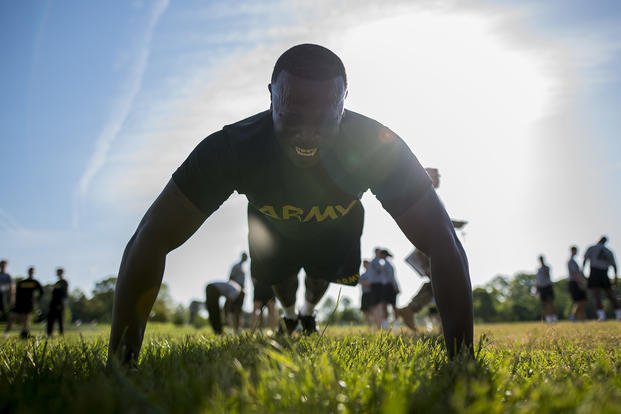If you have time, here is a good workout that has a little bit of everything: short fast runs, a calisthenics superset, pyramids, moderately heavy weights, PT reset exercises and workout-ending cardio events. This workout can take more than 90 minutes even if you move fast, so feel free to break it up into different workouts of the day, if needed. I would recommend breaking the cardio events of running and swimming into a later workout in the day, if needed.
Here is a challenging upper-body workout that starts off “warming up” with short runs and calisthenics. You can do this 10-round superset as fast or as slow as you prefer. You also can adjust the push-ups to range between 10-20. We prefer to do this workout on a track or football field to mark the 200-meter runs easily.
Repeat 10 times
- Run 200 meters
- Push-ups 20
After the warmup, it is time to mix in the two “heavyweight” calisthenics together in a half-pyramid fashion. This is set up to start easy and build up to 10 sets, but multiply by two each set. The rest is a short bit of core activity for a minute or more if you need it. If you cannot handle 2, 4, 6, 8, 10 … up to 20 reps of the pull-up/dip pyramid – reduce to single digits (1, 2, 3, 4, 5 … up to 10). Here is how it looks:
Pull-up/dip pyramid 1-10 (110 total reps of each)
- (stop at 10)
- Pullups x 2
- Dips x 2
- Rest with plank or abs of choice one minute when needed
2 pullup, 2 dips; 4 pull-ups, 4 dips; 6 pull-ups, 6 dips (rest with abs/plank when needed) … keep going up to 20 pull-ups/20 dips if you can.
If you have anything left, try a heavy bench press and weighted pull-up set. Rest as needed between exercises; this one requires a bit more recovery time. Try moderately heavy weights for the bench press and a weighted pull-up, if possible. If you cannot do pull-ups, replace with a heavier pulldown or row exercise.
Repeat 3 times
- Bench press 5 (heavy)
- Weighted pull-ups 5-10
- Plank or sit-ups one minute -- if you have to take a sit-up test (or plank pose), add this exercise as an active rest.
Dumbbell and PT reset exercises -- The next three sets focus on a few isolation exercises for biceps and shoulders as well as the rear deltoids, upper back and smaller shoulder muscles. The two dumbbell exercises at first are biceps curls that move into the military press. Then the shoulder shrugs are simply lifting the shoulders up and down while holding the dumbbells by your side.
Repeat 3 times
- DB biceps/mil 10
- DB shrugs 10
- Rev push-ups 10
- Birds 10
- Arm haulers 10
Lightweight shoulders -- This is a lightweight (no more than five pounds needed) shoulder workout to help with isolating smaller rotator-cuff muscles safely. It is a good cooldown workout as you get ready to leave the weight room and start the cardio phase.
Cardio section -- Running and swimming (or another form of non-impact cardio activity) are great ways to complete a tactical fitness workout. These two workouts are not particularly long individually, but it depends on the rest/recovery time between sets needed for the individual.
Run 1.5 miles timed, or you can opt to work on 6 x 400-meter sets of goal-paced running. If your next running goal is a nine-minute, 1.5 mile timed run, shoot for 6 x 90-second 400m runs with a short one-minute walk between sets.
Swim -- This workout is a classic for getting better for military swim tests in the 500-meter range.
Swim 500-meter warmup -- Warming up with the distance that you will be tested on is a great way to turn a test “into just a warmup.” This will help you frame this test mentally and reduce anxiety that typically occurs with these tests.
Repeat 10 times
- 50m free fast
- 50m CSS goal pace
The CSS (combat swimmer stroke) is used by many groups in the military. It is actually a sidestroke that is modified slightly from the elementary sidestroke taught by many YMCA lifeguard courses. This workout of mixing in freestyle with an efficient CSS will get you into competitive swimming scores quickly. Just do it several times a week so you master technique as well as get into swimming shape.
Stew Smith is a former Navy SEAL and fitness author certified as a Strength and Conditioning Specialist (CSCS) with the National Strength and Conditioning Association. Visit his Fitness eBook store if you’re looking to start a workout program to create a healthy lifestyle. Send your fitness questions to stew@stewsmith.com.
Want to Learn More About Military Life?
Whether you're thinking of joining the military, looking for fitness and basic training tips, or keeping up with military life and benefits, Military.com has you covered. Subscribe to Military.com to have military news, updates and resources delivered directly to your inbox.
















